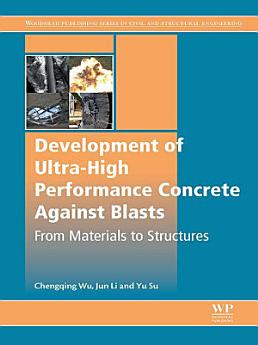Development of Ultra-High Performance Concrete against Blasts: From Materials to Structures
Chengqing Wu · Jun Li · Yu Su
Mar 2018 · Woodhead Publishing
Ebook
422
Pages
family_home
Eligible
info
reportRatings and reviews aren’t verified Learn More
About this ebook
Development of Ultra-High Performance Concrete against Blasts: From Materials to Structures presents a detailed overview of UHPC development and its related applications in an era of rising terrorism around the world. Chapters present case studies on the novel development of the new generation of UHPC with nano additives. Field blast test results on reinforced concrete columns made with UHPC and UHPC filled double-skin tubes columns are also presented and compiled, as is the residual load-carrying capacities of blast-damaged structural members and the exceptional performance of novel UHPC materials that illustrate its potential in protective structural design. As a notable representative, ultra-high performance concrete (UHPC) has now been widely investigated by government agencies and universities. UHPC inherits many positive aspects of ultra-high strength concrete (UHSC) and is equipped with improved ductility as a result of fiber addition. These features make it an ideal construction material for bridge decks, storage halls, thin-wall shell structures, and other infrastructure because of its protective properties against seismic, impact and blast loads. - Focuses on the principles behind UHPC production, properties, design and detailing aspects - Presents a series of case studies and filed blast tests on columns and slabs - Focuses on applications and future developments
About the author
Dr Wu is Professor of Structural Engineering at University of Technology Sydney Australia. He is currently the Chair of the Australian Chapter of the International Association of Protective Structures (http://iapsaustralia.org/ (external link)). Since Dr Wu obtained his PhD from School of Civil and Environmental Engineering, Nanyang Technical University, Singapore in 2002, he has developed recognized and diverse research on blast-induced ground vibrations, structural response to blast loading, mitigation of blast effects on structures, blast resistance of ultra-high performance concrete etc. So far Dr Wu has attracted more than 4 million dollars research funding from the Australian Research Council (ARC), the Defence Science and Technology Organization (DSTO) Australia and other organizations. He is the editors of three conference proceedings, two ASCE special issues, author or co-authors of more than 220 referred international journal papers and conference papers in blast and impact areas. Dr Wu has served on a number of international conference committees and chairmanship, undertaken guest editorships. Dr Wu is also currently an associate editor of ASCE Journal of Performance of Constructed Facilities and an editorial board member of International Journal of Protective Structures.Dr. Jun Li is a Lecturer in the School of Civil and Environmental Engineering, at the University of Technology Sydney. He received his Bachelor's Degree in Civil Engineering from Central South University in China, and his Doctorate of Philosophy in Civil Engineering from the University of Western Australia. Dr. Li has contributed to over 30 journal publications, 15 Conference papers and some of his research interests include: blast effects simulation, the development of ultra-high performance concrete, sacrificial metallic foam and meso-scale modelling for concrete and steel fibre concrete.Dr. Yu Su is a visiting research fellow in School of Civil and Environmental Engineering, at University of Technology Sydney and he worked as a research associate at the University of Adelaide before joining UTS. Dr Su received his Doctorate of Philosophy in Civil/Structural Engineering from the University of Adelaide. Dr. Su gained profound experiences in mix design of high performance materials including UHPC and polymer composites and the UHPC he developed has successfully been applied in protective structures.
Rate this ebook
Tell us what you think.
Reading information
Smartphones and tablets
Install the Google Play Books app for Android and iPad/iPhone. It syncs automatically with your account and allows you to read online or offline wherever you are.
Laptops and computers
You can listen to audiobooks purchased on Google Play using your computer's web browser.
eReaders and other devices
To read on e-ink devices like Kobo eReaders, you'll need to download a file and transfer it to your device. Follow the detailed Help Center instructions to transfer the files to supported eReaders.






